 |
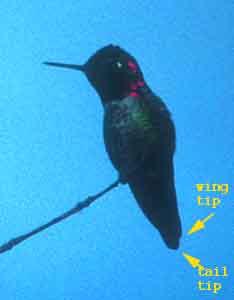 |
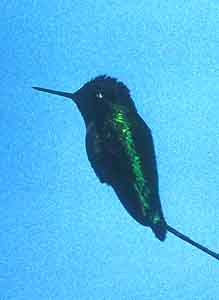 |
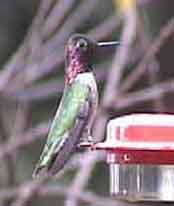
Rita Carratello and I had found an apparent male Costa's Hummingbird at this feeder two days before (18 Dec 2001), quite a nice rarity in Santa Cruz County. My MBB chat line post had read (in part): "The Costa's has a complete glittering violet gorget, crown, and small patch on auriculars and very long "tails" to the lower corners of the gorget.... It was particularly interesting to watch the glittering colors in differing lights, sometimes with a heavy blue highlight and sometimes red (esp. in the "tails") and sometimes even a green flash down the center of the gorget. I wonder if age/wear affects these glittering properties (seems likely). It has a very nice crisply white post-ocular line going down and connecting with a very white "collar" effect on upper breast that sets off the gorget nicely. Although no Anna's nearby to compare, it looked small, short-tailed, and not as hefty as an Anna's."
Review of Carol's photos and the new hummingbird i.d. book by Steve Howell (Howell 2002) led Kumaran Arul to wonder if it the bird captured there really was a Costa's Hummingbird; he posted MBB comments suggesting it was a hybrid Costa's X Anna's or an F2 hybrid [e.g., a backcross between a hybrid and another "pure" parental type]. His full discussion (incorporating comments by Peter Pyle) is in an Appendix below, but in short he felt (based on the photo review only) that the bird was more likely a hybrid than a pure Costa's because
I'll begin this discussion with reviewing these characters in unambiguous males of the two species. In these three shots of adult male Anna's Hummingbird, note the following points. On the left hand shot, see the extent of the gorget "tails" which can be somewhat elongated but the extension is round and broad. Also, the background white color is dingy and there is little white above the gorget (e.g., behind the eye and below the auriculars). The right two shots are of the same male front and back. Both shots show the long tail of Anna's compared with the wingtips (labeled in the middle shot), show the straight bill, and show the red-rose tint of the gorget. The frontal view shows the typically very dingy underparts of Anna's with much mottling not only on the flanks but across the whole underparts; this photo also shows the straight-edged lower border of the gorget across the chest. The righthand photo shows the bright green back color, and the typical white spot behind the eye.
 |
 |
 |
These next three shots are of male Costa's Hummingbird; again, the right hand two photos are of the same bird. The lefthand shot shows the extent of the gorget tails and the violet (sometimes blue) tint, shows the rather bright white background color both above and below the gorget, and shows how the underparts generally appear more white in the center with green mottling restricted to the flanks. The center photo shows the short tail (often shorter than the tip of the wingtips) and the knife-like downward extension of the longest gorget feather. The righthand photo shows the upward-pointed "V" shape of the gorget against the white throat, a "white eyebrow" effect (rather than just a white spot), and the duller green tone to the back and rump. The photos also hint at a slightly decurved bill.
 |
 |
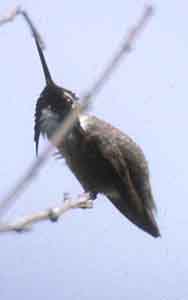 |
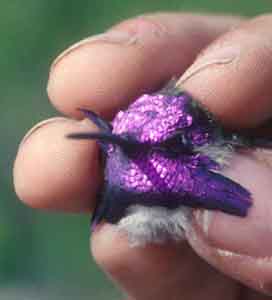 |
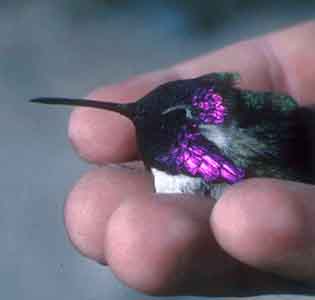 |
Now to the Santa Cruz hummingbird with these points in mind. I have enlarged one previously posted photo to look at some details:
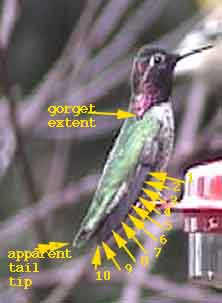 |
This photo shows a longish gorget extension but not as long as some of the males above. It also apparently shows a tail tip that is longer than the wingtip. At first I wondered if this could be explained by wing molt but I think I can count all 10 primary tips as labeled here. However, see below on the tail tip question. I also see a point of white from the breast extending up toward the chin, more like typical Costa's than typical Anna's. |
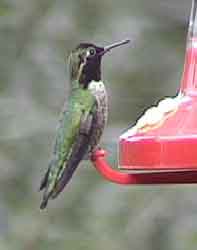 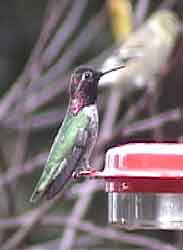 |
I have flipped the horizontal image of the Prunedale Anna's so it is at the same position as the Santa Cruz bird; both are from the same video camera so color matches should be close. The Anna's (left) looks like it has a longer tail, a slightly greener back, and a longish but rounded "tail" to the gorget. I think the Santa Cruz bird (right) has a very slightly decurved and slightly thinner bill in comparison. It also has more white on the chest. But the eyering and white line behind the eye are similar. |
At my request, Carol Anderson graciously made additional snaps of her video that have not been previously posted as single shots. These show a bird much more like that I recall and described: a short tail (shorter than wingtip), a long gorget extension, and rather clean white background color below the gorget (both above and below). The back color is also not bright glittering green (like Anna's) but a duller green consistent with Costa's.
 |
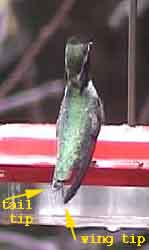 |
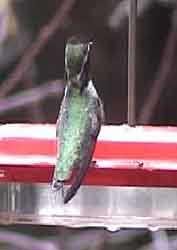 |
I have now watched Carol's entire video, and all her shots are of the same bird coming the same feeder just before and just after a visit by the Black-throated Blue Warbler. These above three video-pics are consistent with the bird we saw, and I believe this is how the bird looked. Thus the previously posted captures (like the first one at the top of the page or the enlarged shot with numbered primaries) are misleading, at least as to the tail length.
 However,
the above shots also strongly suggest to me that while the right wing has
all its primaries, the left wing may be molting its outermost primaries
and could be missing P10 or maybe even P9 and P10. Thus the apparent length
of the left wing tip in this shot (right), used by Arul to suggest the
Santa Cruz bird was long-tailed, is very misleading.
However,
the above shots also strongly suggest to me that while the right wing has
all its primaries, the left wing may be molting its outermost primaries
and could be missing P10 or maybe even P9 and P10. Thus the apparent length
of the left wing tip in this shot (right), used by Arul to suggest the
Santa Cruz bird was long-tailed, is very misleading.
Carol's video also captures two shots of apparent tail-wagging behavior (below) that seem to me to be consistent with Costa's (admittedly, I did not make a note of this at the time, nor did we hear any vocalizations).
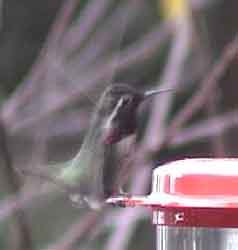 |
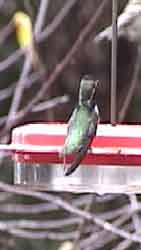 |
But now look at two shots by Bruce Barrett at the Spencer feeder in January 2002:
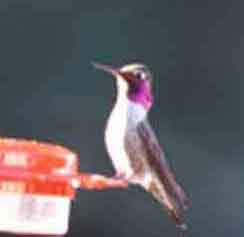 |
 |
What does one make of this bird? First, the shots are overexposed since no hummer in this genus has a white throat like the lefthand pic, and the gorget is actually all there (in the righthand pic). I also note that this male does not have the single long gorget extension shown in all the shots of the December bird. But the violet glow on the lefthand bird is unlike any possible Anna's and is a very close match to the in-hand Costa's shown above. Even the deep crimson of the righthand shot is unlike any Anna's (which is rosy-red when fresh, wearing to orangey-red). This red color is something that was not present on the December bird no matter which angle it was at -- the only red highlight was in the elongated "tail" of the gorget. This same feather glowed blue in other lights. It could be that this red color in the righthand photo is entirely an artifact of the camera or that it illustrates irridescence in feathers of a very worn gorget (see below).
The color aspects to the Santa Cruz might be attributed to wear. Howell (2002) states that primary molt in Anna's "starts May to August, ends August to December; averages later on immatures..." For Costa's, primary molt "starts May to October, ends September to January; averages later on immatures." The fact that it looks like that the Santa Cruz was still completing primary molt in December (apparently missing one or two outer longest primaries on left wing) suggests Costa's (marginally). It might also mean that even P10 on the right wing was not entirely grown.
Howell (2002) explains (in the introduction, p. 28) that primary molt progresses from the P1 (innermost primary) to P10 (outermost) and that while inner primaries are replaced rapidly, outer primary molt "is quite protracted and may even by suspended at times." The body molt starts with the rump and progresses forward; the "last feathers replaced ... are usually the head feathers, most obviously the gorgets of males" which are not replaced until or after the outer primary molt.
What this means is that the Santa Cruz bird had a very worn gorget or that it was just starting to replace the gorget. Either through wear or molt, the very long knife-like extensions at the corners of the gorget were worn or missing. This could easily explain that part of the gorget shape. The fact that Rita and I noticed so much color variance in that particular part of the gorget is consistent with an old feather. Assuming that the bottom two photos are the same bird, the longest feather photographed on the gorget in December was missing by January. It is possible that an even longer gorget feather that Rita and I saw on 18 December was gone by 20 December. I think this is a reasonable hypothesis since my attention was first drawn to the "very long "tails" to the lower corners of the gorget" described in my field notes, rather than the violet color. I recall first noting the "tails" from behind when they extended way back beyond the head.
So let's consider the points made that suggested this bird was not a pure Costa's:
I have not yet had the opportunity to review the article mentioned by Pyle [Wells et al., Auk 95:537-549, 1978], but for the moment all the characters used to suggest this was not a Costa's can be either explained by molt or wear, or are subjective and open to interpretation. About 30 years ago I did visit a feeder that had an apparent Anna's X Costa's hybrid, and my recollection is that it looked like a Costa's but sounded like an Anna's. I also briefly encountered another similar bird in the upper Arroyo Seco watershed about 20 years ago. But my impression remains that the Santa Cruz bird is as easily explained as a pure male Costa's near the end of its molt as it is by introgression of Anna's genes. Every important character is consistent with Costa's.
If anything, the experience illustrates just how difficult it is to make identifications from photographs, and particularly from just one or two photos rather than a series. As Peter Pyle stated: "It is difficult to be sure of anything when viewing images on the computer."
This was a great review of hummingbird characters, and also illustrated just how useful the new Howell book is (one does not get the same degree of detail in the new hummer book in the Peterson series). I am not sure we can say for sure what the bird was. While it is consistent with a worn and molting Costa's in many aspects, many of the subjective points could be explained by introgression of Anna's genes. The "hybrid theory" is a hypothesis that cannot be excluded. Yet, we rarely engage this hypothesis when the details can, in fact, be explained by wear or molt in "pure" birds.
I welcome further comments and thoughts at creagrus@montereybay.com. I thank Kumaran Arul for his excellent analysis, Peter Pyle for his thoughts, and David Suddjian for encouraging this entire discussion. Carol Anderson was ever so helpful with making snaps from her video, and Bruce Barrett graciously consented to the use of his shots. And Madeline Spencer started it all with her hospitality and her bird feeders.
Don Roberson
Pacific Grove, Monterey Co. CA
PHOTOS: All but the final two shots of the Santa Cruz hummer are © 2002 Carol Anderson (as is the Anna's from her own feeder); the final two shots are © Bruce Barrett, all used with permission; all rights reserved. The row of three Anna's are all © 2002 Don Roberson: lefthand bird 7 May 1982 Chews Ridge, Monterey Co., and righthand two photos Nov 1997 Goleta, Santa Barbara Co. On the row of three Costa's the lefthand bird is © J. Van Remsen and was taken in Feb 1976 in Pinto Canyon, Imperial Co.; the righthand two shots are of the same male in Bixby Canyon, Monterey Co., on 2 June 1981. The two in-hand Costa's are © J. Van Remsen and were taken in May 1976 at Ft. Piute, San Bernardino Co.
LITERATURE CITED
Howell, S. N. G. 2002. Hummingbirds of North America: the Photographic Guide. Academic Press, London.APPENDIX
Hi David,
I was still bugged by the Costa's Hummer photos (at http://www.thefevre.com/birds/)
after studying Steve Howell's book "Hummingbirds of North America, the
Photographic Guide" and a few other sources. It still came up Anna's to
me. So, the unfortunate stubborn side of me took over (please accept my
apologies), and I decided to consult with the author for additional perspective.
But, I couldn't find his web address. I did, however, find Peter Pyle's
web address in the process and his name was included in many cites. So,
after querying him as to the photos, he gave the following response (2/6/2002).
The bird in the photos looks more like Anna's than Costa's to me. The only thing against Anna's would be the elongated tail to the gorget and (perhaps) too much purple to the gorget, whereas the thickness of the gorget tail, the color of the head (too pink), the dingy underparts, and the thickish and straightish bill go against Costa's. It is difficult to be sure of anything when viewing images on the computer, but my guess would be that your bird is a hybrid Anna's X Costa's or F2 back-cross (hybrid X Anna's) which would easily explain the anomalous appearance. This hybrid combination is relatively common in nature. See Wells et al. Auk 95:537-549, 1978. Hope this helps.This brought out a possibility I had not even considered and reminded me of some possible problems with IDs in general. I haven't checked his site yet for greater details on hybrid bird characteristics, but I did carefully re-examine the photos and other sources. In clarifying my thoughts, I wrote up some additional factors for the ID which I have included below. To be sure, I don't think this has any relevance to the record, unless it can be safely determined that the bird in the photos is the one originally (and repeatedly) observed as Costa's. It has been in any case a very educational study.Peter Pyle
I would add the following thoughts to those above. (1) I was most convinced for Anna's by the tail tip extension shown fairly clearly in the second photo. It shows a fairly long tail that extends past the wingtips. You can just see the left wingtip extending under the tail and above the right wingtip. Even considering the angular "distortion" that might make things seem mis-aligned in a photo, I still feel that it shows the tail extending out past both visible wingtips. (The video, which I haven't seen, would be very helpful in confirming this.) Howell mentions this as almost a diagnostic feature difference between the two species in adult males. (2) In addition the overall appearance (accepting this as being particularly prone to the photo distortion) seems to be of a longer, bigger bird. The head and back appears big and tall, not compact and short, but I'll admit this is rather difficult to "prove". (3) The color of the back is noteworthy for its very complete green look, as opposed to the more spotty (and thus less brilliant) green seen on typical Costa's. (4) These last three factors point fairly directly to Anna's, but the next two cause the most problems, the gorget color and gorget length. With color, I basically think it comes down to a subjective matter of degree, because, I have seen shots of Costa's that do show some reddish component to the color, and I have seen some shots of Anna's that show some purplish component to the color. I believe this is due obviously to the angle of reflection and perhaps even the color of the light source. But, in addition Howell notes that the degree of wear of the gorget plumage can also cause different color to show, probably due to different refractive characteristics. He notes that Anna's can seem more "orange-red" when the plumage is worn. I would guess that Costa's can appear more magenta/red when the plumage is worn too. My subjective view sees enough reddish to tilt it towards Anna's, but it would probably be better not to consider this factor too heavily. It does seem to fall right in the middle range, which is why Peter Pyle's hybrid would be a very nice compromise. (5) Gorget length is another tricky issue. Because in certain body angles both birds can appear to have shorter or longer gorgets. Also there is clearly individual variance (seen in photos). I have at least two Anna's photos showing significant extension, one of which shows as much as this bird, possibly more. I also wonder with length as with color whether there is any variance associated with age (i.e. young males vs. old males) and fresh vs. old plumage. Could some of the gorget feathers have molted off the Costa's or could it be a very fresh young Anna's with a few extra feathers? So, again length seems a subjective consideration, and again, I would hedge towards Anna's, but only because of the following related points. (Again Pyle's hybrid is a nice compromise). (6 ) In any case, the typical Costa's, unlike this bird, shows not just the extension and color, but a rather thin and very long and rather vertical extension, that sometimes makes it look very "linear", like a knife poking down through the white "scarf". (7) There would also be a fairly distinct arch-like curvature to the lower rim of the gorget on the throat which ends up showing a fair amount of white on the throat, above the dingier breast colors. (8) Also, there would be a white patch "behind" the gorget (under the ear). This bird shows a very straight gorget base all the way across the throat (like Anna's) with debatable 'white' under it and almost no white patch behind the gorget on the neck. (9) Also, many Costa's show a pale gray eye "stripe" above the eye towards the bill, giving the eye a little "brow" and making the eye "ring" not appear "rounded". This bird seems to show a more rounded white around the eye.
Given these factors, calling this bird a hybrid of some sort does seem safe. But, I really would like to research more extremes of variance in clear non-hybrid birds before giving up on the many clear Anna's characteristics. It would also be useful to have the information suggested by Pyle on characteristics of known hybrids. Howell only mentions "presumed hybrids that can look like Costa's but have calls more like Anna's or of intermediate quality". But, even calling it a hybrid causes some difficulty, because the abnormal features may have come from an unexpected species. (For example, Terres mentions reported hybrids for Anna's with Black-chinned, Allen's, and Calliope; could this last one create elongated gorget feathers on an otherwise Anna's looking bird?).
The critical (and possibly defining) clues not considered here would be voice and behavior (like a lot of tail flipping at the feeder). I think the video clip would aid significantly in many factors, but, I haven't been able to get to a friend's PC yet.
Hope this is at least interesting, if not useful.
Kumaran